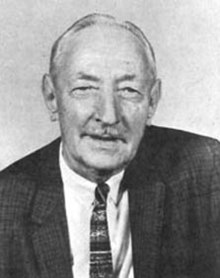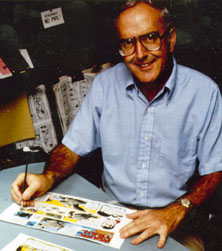
A cartoonist is a visual artist who specializes in both drawing and writing cartoons or comics. Cartoonists differ from comics writers or comic book illustrators in that they produce both the literary and graphic components of the work as part of their practice. Cartoonists may work in a variety of formats, including booklets, comic strips, comic books, editorial cartoons, graphic novels, manuals, gag cartoons, storyboards, posters, shirts, books, advertisements, greeting cards, magazines, newspapers, webcomics, and video game packaging.

Jules Ralph Feiffer is an American cartoonist and author, who was considered the most widely read satirist in the country. He won the Pulitzer Prize in 1986 as North-America's leading editorial cartoonist, and in 2004 he was inducted into the Comic Book Hall of Fame. He wrote the animated short Munro, which won an Academy Award for Best Animated Short Film in 1961. The Library of Congress has recognized his "remarkable legacy", from 1946 to the present, as a cartoonist, playwright, screenwriter, adult and children's book author, illustrator, and art instructor.

Royston Campbell Crane, who signed his work Roy Crane, was an American cartoonist who created the comic strip characters Wash Tubbs, Captain Easy and Buz Sawyer. He pioneered the adventure comic strip, establishing the conventions and artistic approach of that genre. Comics historian R. C. Harvey wrote, "Many of those who drew the earliest adventure strips were inspired and influenced by his work."
Bradley Jay Anderson was an American cartoonist and creator of the comic strip Marmaduke.

Noel Douglas Sickles was an American commercial illustrator and cartoonist, best known for the comic strip Scorchy Smith.
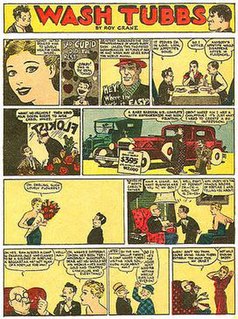
Wash Tubbs is an American daily comic strip created by Roy Crane that ran from April 14, 1924 to 1949, when it merged into Crane's related Sunday page, Captain Easy. Crane left both strips in 1943 to begin Buz Sawyer, but a series of assistants, beginning with Leslie Turner, kept the combined Captain Easy daily and Sunday strips going until October 1, 1988.

Captain Easy, Soldier of Fortune is an American action/adventure comic strip created by Roy Crane that was syndicated by Newspaper Enterprise Association beginning on Sunday, July 30, 1933. The strip ran for more than five decades until it was discontinued on October 1, 1988.
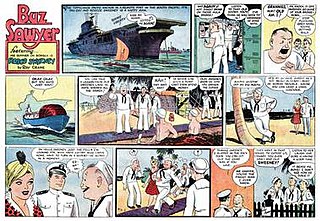
Buz Sawyer is a comic strip created by Roy Crane. Distributed by King Features Syndicate, it had a run from November 1, 1943 to October 7, 1989. The last strip signed by Crane was dated 21 April 1979.

A topper in comic strip parlance is a small secondary strip seen along with a larger Sunday strip. In the 1920s and 1930s, leading cartoonists were given full pages in the Sunday comics sections, allowing them to add smaller strips and single-panel cartoons to their page.

The Newspaper Enterprise Association (NEA) is an editorial column and comic strip newspaper syndication service based in the United States and established in 1902. The oldest syndicate still in operation, the NEA was originally a secondary news service to the Scripps Howard News Service; it later evolved into a general syndicate best known for syndicating the comic strips Alley Oop, Our Boarding House, Freckles and His Friends, The Born Loser, Frank and Ernest, and Captain Easy / Wash Tubbs; in addition to an annual Christmas comic strip. Along with United Feature Syndicate, the NEA was part of United Media from 1978 to 2011, and is now a division of Andrews McMeel Syndication. The NEA once selected college All-America teams, and presented awards in professional football and professional [NBA] basketball.

James Scancarelli, known professionally as Jim Scancarelli, is an American cartoonist and musician. Since 1986, he has been writing and drawing the syndicated comic strip Gasoline Alley for Tribune Media Services. In that role, his predecessors were Frank King, Bill Perry and Dick Moores. He had served as an assistant to the latter for several years before taking over. Scancarelli is also a prizewinning bluegrass fiddler.

William Pierce Hoest was an American cartoonist best known as the creator of the gag panel series, The Lockhorns, distributed by King Features Syndicate to 500 newspapers in 23 countries, and Laugh Parade for Parade. He also created other syndicated strips and panels for King Features.
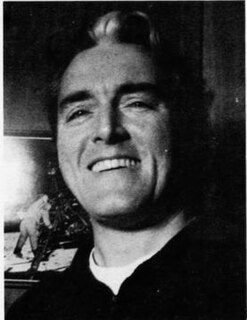
Frank Springer was an American comics artist best known for Marvel Comics' Dazzler and Nick Fury, Agent of S.H.I.E.L.D.. As well, in collaboration with writer Michael O'Donoghue, Springer created one of the first adult-oriented comics features on American newsstands: "The Adventures of Phoebe Zeit-Geist" in the magazine Evergreen Review. A multiple winner of the National Cartoonists Society's Reuben Award, Springer was a president of the Society and a founding member of the Berndt Toast Gang, its Long Island chapter.
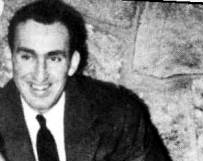
Creig Valentine Flessel was an American comic book artist and an illustrator and cartoonist for magazines ranging from Boys' Life to Playboy. One of the earliest comic book illustrators, he was a 2006 nominee for induction into the comics industry's Will Eisner Hall of Fame.
Ray Billingsley is an American cartoonist, the creator of the comic strip Curtis, which is distributed by King Features Syndicate and printed in more than 250 newspapers nationwide.

Woodrow Gelman was a publisher, cartoonist, novelist and an artist-writer for both animation and comic books. As the publisher of Nostalgia Press, he pioneered the reprinting of vintage comic strips in quality hardcovers and trade paperbacks. As an editor and art director for two-and-a-half decades at Topps Chewing Gum, he introduced many innovations in trading cards and humor products.

Out Our Way was an American single-panel comic strip series by Canadian-American comic strip artist J. R. Williams. Distributed by Newspaper Enterprise Association, the cartoon series was noted for its depiction of American rural life and the various activities and regular routines of families in small towns. The panel introduced a cast of continuing characters, including the cowboy Curly and ranch bookkeeper Wes. Out Our Way ran from 1922 to 1977, at its peak appearing in more than 700 newspapers.
Robert C. Harvey was an American author, critic and cartoonist. He wrote a number of books on the history and theory of cartooning, with special focus on the comic strip. He also worked as a freelance cartoonist.
Tom Moore was an American cartoonist and member of National Cartoonists Society, known for his work on the Archie Comic Book series in the late 1950s, and then again in the late 1980s.
OrlandoCon, also known as O'Con, was a long-running comic book fan convention which was held annually between 1974 and 1996 in Orlando, Florida. The first comic book convention held in the Orlando area, OrlandoCon billed itself as a "Central Florida comic art convention and early TV/film festival." Captain Marvel-creator C. C. Beck was a regular guest of the show; as were many other Golden Age of Comic Books creators who lived in the Orlando area.
